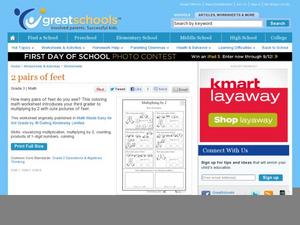Curated OER
Connect the Rhymes
Connect these rhyming images. There are two sets of six familiar pictures here, and scholars draw a line from the left objects to their rhyming partners on the right. The images may be difficult for learners to identify, so be sure this...
Curated OER
Reading Practice: Winnie-the-Pooh
Whether your first graders can read or not, they will enjoy this comprehension activity. They read or listen to an excerpt from a Winnie-the-Pooh story, they predict what will happen next, then draw Pooh Bear's favorite food. A compare...
DK Publishing
2 Pairs of Feet - Multiplying by 2
Introduce mathematicians to multiplication through counting sets of feet. Start by asking them, "How many feet are in this classroom?" See if they notice that it's easier to count pairs rather than individual feet. Scholar use the...
Curated OER
And 2 More Makes...
If we add two more, how many does it make? Before youngsters start with addition, give them this clearly worded exercise to help them grasp the concept. Kindergartners focus on the term more as they examine...
Curated OER
Counting: Connecting Pictures and Numbers
As young scholars begin connecting numbers with values, help them grasp this concept with sets of objects like these. They examine five sets (up to 15 in number) and match each to a corresponding digit. Then, they draw a set of their own...
DK Publishing
Learning 11 and 12 - Write the Numbers
Make number concepts fun with this party-themed set of activities aimed at familiarizing young counters with 11 and 12. They begin by tracing each numeral before printing it once on their own. Next, learners count a set of...
DK Publishing
Learning 6 - Write the Word
Which plate has six cookies? Focus on the number six with novice counters as they solidify single-digit number concepts. Keep in mind pre-readers may have trouble with this, as there are written instructions they will need to...
DK Publishing
Sorting the Trees
Perfect for a math lesson during your apple unit. Kindergartners count the apples on each tree, and then count how many trees have three, four, and five apples. Once they're done counting, they draw three trees with different amounts of...
DK Publishing
Using the 2 Times Table, Part 3
Visualize multiplication with cartoon eyes and ears. Third graders count the pairs of eyes in each box, write the multiplication equation, and solve the problem. The second part of the activity provides space for learners to add their...
Curated OER
Using Clocks: Analogue Clocks
What time is it? Have the class practice telling time to the half hour by reading and labeling each of eight clocks. On a second set of eight clocks, they use the time shown to draw in the missing clock hands. An answer sheet is...
Curated OER
Working with 10s and 1s
Can your first graders count by 1s? What about by 10s? Use this graphic learning exercise to help youngsters visualize place value and counting. They count how many sets of 1s or 10s they see, then they draw a given number of 1s or 10s....
Curated OER
Working with 10s and 1s, Part 2
Practice place value by visualizing 10s and 1s. First graders count the cubes in each place, then write the total number at the bottom. In one particularly helpful section, they draw the cubes that will add up to a given number. Bring in...
Curated OER
Be Kind to Mother Nature!
A clever worksheet on identifying things that harm the environment is here for you. Elementary schoolers read a short paragraph describing the harm that can come to the environment due to human activities. Then, they must circle five...
Curated OER
What's for Dinner?
Simply draw a line from the Spanish word to its English meaning. There are 11 vocabulary words presented including leche, encurtidos, caramelo, and manzana. A quick assessment!
Illustrative Mathematics
Origami Stars
This one problem concentrates on the important concept of dividing a whole number by a unit fraction. Here, young mathematicians use pictures they draw to help answer this problem. Insight into the connection between multiplication and...
Curated OER
Comparing Fractions
Learners compare three sets of fractions using the greater than, less than, and equal signs. To justify their answers, a drawing is also required that illustrates their reasoning. Including fractions with like and unlike denominators, as...
Illustrative Mathematics
The Intersection of Two Lines
Here is an introduction to solving simultaneous linear equations. Start by drawing a line through two points. Create a second line which goes through the intersecting point. Background knowledge of how to find the equation of a line and...
Curated OER
Which is Closer to 1?
A seemingly simple question that reveals a lot about a student's understanding of fractions. In finding an answer, learners compare fractions with different denominators that are both greater and less than one. No number line is...
Education Center
Real or Make-Believe?
A worksheet about Officer Buckle and Gloria by Peggy Rathmann challenges young learners to decide which story events could be real, and which could be make-believe. After writing the events in each space, they then use the back of...
Fun Music Company
Compound Time
To demonstrate their understanding of simple and compound time signatures, young musicians complete a chart by drawing quarter or dotted quarter notes equal in value to the note groups shown.
Fun Music Company
Writing Major Scales
Designed as an assessment of understanding, this one-page worksheet asks musicians to demonstrate their understanding of scales by drawing C, G, and F Major scales on the provided staffs.
Fun Music Company
The Bass Clef
Every Good Boy, and girl for that matter, will do just fine with this activity as they are asked to correctly trace and then draw bass clefs on the provided learning exercise.
Have Fun Teaching
Making Inferences Special Night (12)
Young writers will enjoy clowning around with this worksheet that asks them to use clues in Katie's story to infer what is happening. Careful readers won't be tricked. The activity is a real treat.
Jordan-Granite Consortium
Scatter Diagram
You aced the first test, so your score on the second one shouldn't matter, right? Young pupils first draw a best fit line on a provided scatter plot showing test scores for two different tests. They then evaluate five...
Other popular searches
- Scale Drawings
- Grid Drawings
- Isometric Drawings
- Drawings Weather Instruments
- Mitosis Drawings
- Construct Scale Drawings
- Rube Goldberg Drawings
- Cad Drawings
- Chalk Drawings
- Figure Drawings
- Flower Drawings
- Math Vocabulary Drawings























